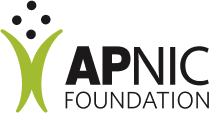TECHNICAL REPORT
| Grantee |
NANO
|
| Project Title | Connecting the Unserved - Bhutan's First Trial with TV White Space Technology |
| Amount Awarded | 30000 |
| Dates covered by this report: | 2020-05-01 to 2020-05-01 |
| Report submission date | 2020-04-30 |
| Economies where project was implemented | Buthan |
| Project leader name |
Tshering Norbu
|
| Project Team |
Tshering Gyeltshen
[email protected]
Jigme Namgyel
[email protected]
Hem Kumar Ghalley
[email protected]
|
Project Summary
This project conducted Bhutan’s first trial with emerging TV White Space (TVWS) technology to deliver broadband Internet access to the unserved areas and determine its appropriateness or not in Bhutan where the terrains are mountainous, thickly forested and rugged, and where building wired network infrastructures is technically and commercially challenging. Implementation timeline was initially scheduled for 8 months – set to start from around 3rd week of October 2018 and complete by June 2019. TVWS was completely new to us being in its early stage of an emerging technology. We researched and studied including case studies of its deployments, and identified potential Original Equipment Manufacturers (OEMs) who were also limited in number. We shortlisted and evaluated three TVWS manufacturers: Carlson Wireless Technologies (US), Runcom Communications (Israel) and Saankhya labs (India). We chose Carlson Wireless. When we were finalizing Bill of Materials after a long design discussion and negotiation with them, we learnt they had long lead time, delay and some cases of even failing to manufacture/supply. That put huge dent to our implementation time. We did not risk and had to switched to another OEM, Redline Communications (Canada) – who carried good recommendation on their company’s credibility and technology performance. Then playing order to Redline who manufactured and supplied/delivered based only on the order consumed several months. We could complete installation of the final site of the total five deployments in March 2020. The entirely in all activities extended our project implementation timeline to 16 months. Major activities included: field survey of two base stations and selecting only one, seven client sites survey and selecting only five; study, evaluation and selection of TVWS OEM; ordering and supply/delivery of equipment; making sites readiness; actual installation, implementation and commissioning of networks - for provisioning Internet; providing support assistance and monitoring of network performances for evaluation.
Table of Contents
- Project factsheet information
- Background and justification
- Project Implementation
- Project Evaluation
- Gender Equality and Inclusion
- Project Communication Strategy
- Recommendations and Use of Findings
Background and Justification
NANO is one of the only three fully-fledged (Tier-1 category by Bhutan’s standard) ISPs in Bhutan licensed to establish international connectivity and cover nationwide. We have own independent international gateway, international connectivity and domestic networks built on the backbone of latest DWDM and fiber technologies including access networks which are completely on fiber. We are a young entrepreneurial startup founded by the top-notch management and technical team that brought Internet and telecommunications (specifically FTTx services) development in Bhutan. As of today, we operate only in three major cities in Bhutan with a focus on providing services to the selected segment of the corporate and enterprise customers.
Project has been deployed to cover the semi-rural areas around the periphery of capital city, Thimphu, Bhutan. Except for one site i.e. Zilukha Nunnery, the rest were hard to reach by wired network. They were off the urban wired (e.g. fiber) network infrastructures.
The communities selected are located in semi-rural areas which had scarce/limited connectivity and were unserved primarily for two reasons: too distant to be connected by the wired network infrastructures and service providers were not motivated as they did not see monetary return after investment to connect using other (wireless) access technologies. Because the communities had low population density and did not have high-paying capacity, they were deprived of good (broadband) Internet connectivity. The communities comprised of three monasteries (the Buddhist institutions of the monks), one nunnery (the Buddhist institution of the nuns) and an unserved residential home which waited for broadband Internet for years until we deployed access with the TVWS technology. We had to forgo some communities/areas identified in the initial proposal and had to replace with new ones as the former were found not feasible during the tests/deployment.
The final communities selected and their geolocations are:
Site 0: Base Station (BS), Latitude: 27.477722°, Longitude: 89.631256°
Site 1: Phajoding Monastery, Latitude: 27.488685° Longitude: 89.574024°
Site 2: Zilukha Nunnery, Latitude: 27.485967°. Longitude: 89.629841°
Site 3: Talakha Monastery, Latitude: 27.416465°, Longitude: 89.677034°
Site 4: Simtokha Monastery, Latitude: 27.438331°, Longitude: 89.669693°
Site 5: Residential Home, Latitude: 27.433605° Longitude: 89.679273°

Base Station and 5 Client Sites
- Site 1: Phajoding Monastery
Located at an altitude of around 3,700 meters, it is one of the richest and most decorated monasteries in Bhutan. It serves as a Buddhist institution for education and learning. It has a principal, 5 teachers and 71 students facilitated by 9 computers and administrative office besides the classrooms.

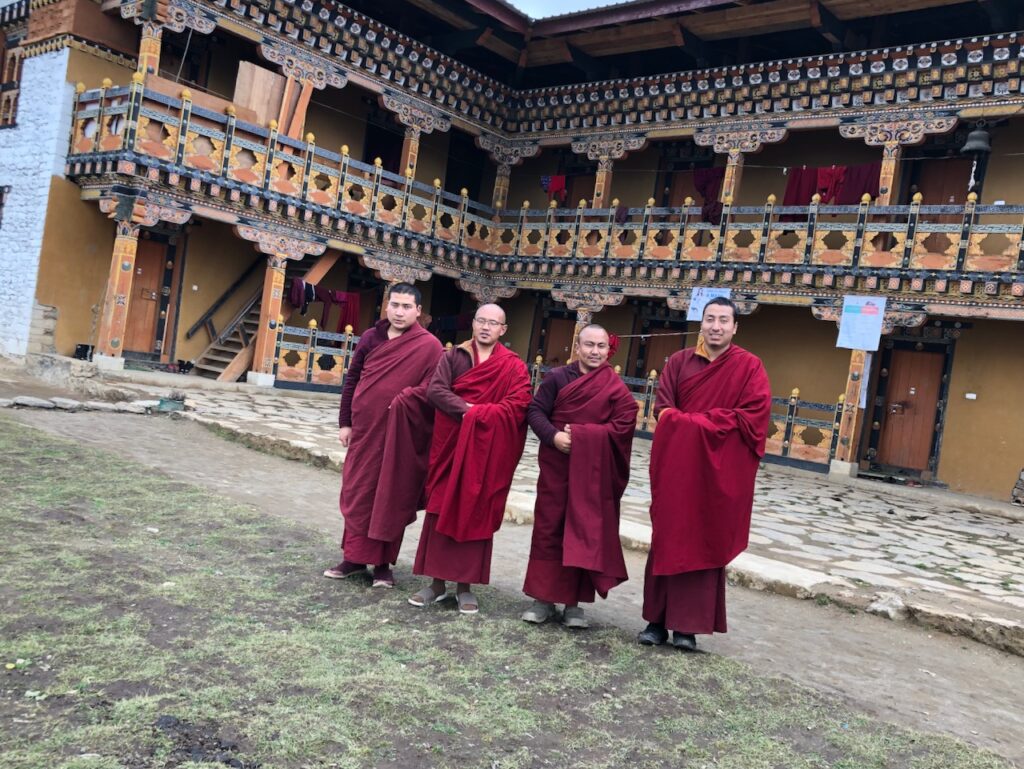
Teachers of Phajoding Monastery
2. Site 2: Zilukha Nunnery
Headed by Rinpoche (a religious teacher held in high regard in Buddhists) and home to 50 student nuns and 3 teachers, it’s located right outside the capital city and is close to base station.

Nuns of Zilukha Monastery
3. Site 3: Talakha Monastery
The monastery has 3 teachers including the Lama (spiritual leader) and 18 students.

Talakha Monastery

Talakha Monastery - Teachers & Student Monks
4. Site 4: Simtokha Monastery
Simtokha Monastery located in Simtokha Dzong (castle-monastery) is of the most profound and the first dzong built in Bhutan. The monastery has 10 teachers including principal, 1 researcher, 2 administrative officers and 90 student monks.
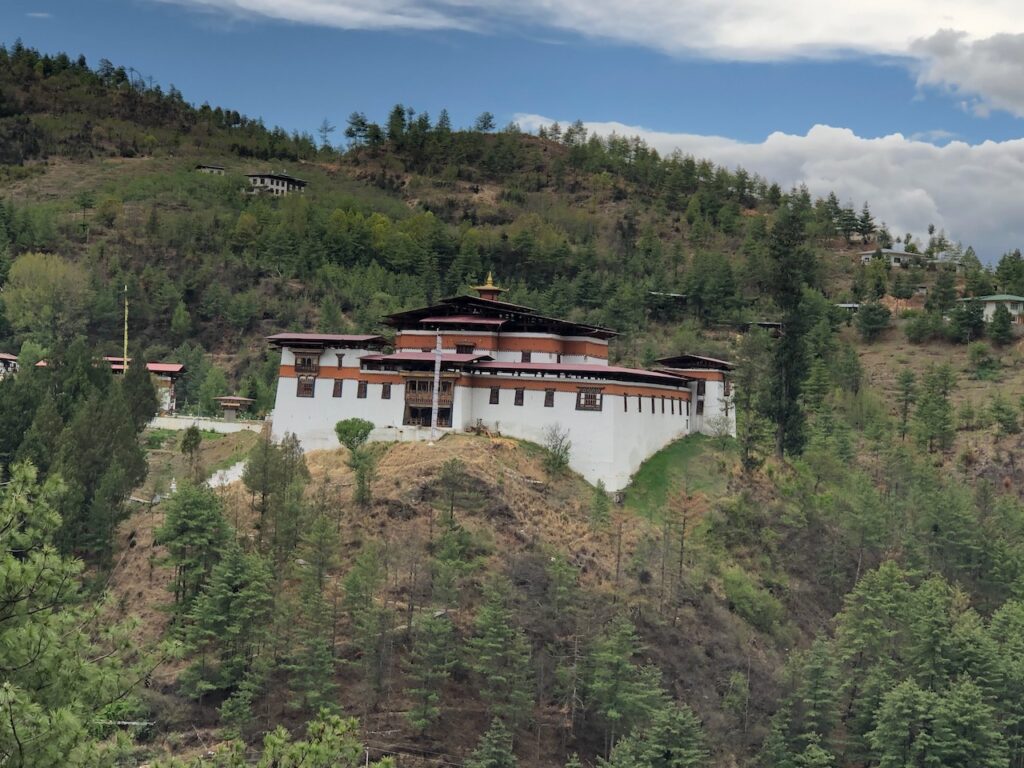
Simtokha Dzong housing Simtokha Monastery

Monk Students of Simtokha Monastery
5. Site 5: Residential Home
A residential home of Jigme (Mr.) was chosen as one of the sites for the reason that he was not able to get fixed broadband connection even after more than a year of trying to persuade ISPs.
Before this project, all the sites lacked and were deprived of broadband Internet access. Even site 2 (Zilukha Monastery) used ADSL broadband much earlier to the project and service had to be terminated as the connectivity on old copper wire was erratic and unreliable. Rest of the sites did not have any option. They used cellular data/Internet on their personal mobile data subscription on 2G and congested 3G – which were slow. 4G signals had very weak coverage in sites 1 and 3 while the rest were fairly covered. Cellular data did not provide reliable and committed performance. All communities preferred stable and committed broadband Internet speed on fixed connectivity. ISPs quoted exorbitant investments to the communities and were asked to share major portion which were not affordable and proved a deterrence.
The project tried solving our major problem in easily provisioning access networks to cater broadband Internet to the semi-rural communities while driving their affordability with the long term objective to increase broadband Internet penetration in the unserved areas so as to bridge gap created by digital divide.
Except for site 2, no past attempt to connect to broadband Internet access was made. That was because the ISPs’ proposals to communities to share high investments proved unaffordable. Both wired and wireless access options were proposed. Certainly, no previous attempt was made to use TVWS technology.
Our motivation for this project came from our conviction and belief that the quickest and the most efficient way in taking broadband Internet to the unserved areas would be by adopting and capitalizing on the emerging TVWS technology. We are the first and still only one so far to have already secured Bhutan's regulatory approval to trial TVWS spectrum to provision Internet. The project is a trial to determine the feasibility to address the efficiency - both technically and financially in taking broadband Internet to the unreached where the service providers are not motivated to go.
We found the technology adequately suitable to help drive the affordability of the users who otherwise were deprived of good Internet connectivity because of lack of proper access networks, which the service providers were not willing to invest owing to the high costs of building the wired networks. The technology would have better edge over other access technologies in technical performance and cost efficiency had the sites been very distant/remote.
Project Implementation
Bhutan is a land-locked country situated in the eastern heart of Himalayas. The terrain is very mountainous, forested and rugged to build wired network infrastructures. It is not possible to lay fiber for backhaul and access networks to most of the areas in Bhutan. Those areas will be deprived of broadband Internet access unless an alternate technology is deployed. In order to address this and as Bhutan's first trial, we implemented an emerging TV White Space (TVWS) technology - to study its feasibility of technology appropriateness to connect broadband Internet to the unserved areas. The trial determined the suitability of TVWS technology to be deployed in Bhutan where the Service Providers are grappling with the challenges of not being able to identify one particular technology to cater fixed broadband service where wired physical network (e.g. fiber) is technically and financially not feasible. We hope providing broadband Internet access to the unserved areas will help our country in curbing rural-urban migration amongst those communities by making rural living attractive thereby narrowing the digital divide gap and increasing broadband penetration.
Major activities planned included: field survey of two base stations and selecting only one, seven client sites survey and selecting only five; study, evaluation and selection of TVWS OEM; ordering and supply/deliver of equipment; making sites readiness including construction of tower for base station; actual installation, implementation and commissioning of networks - for provisioning Internet; providing support assistance and monitoring of network performances for evaluation.
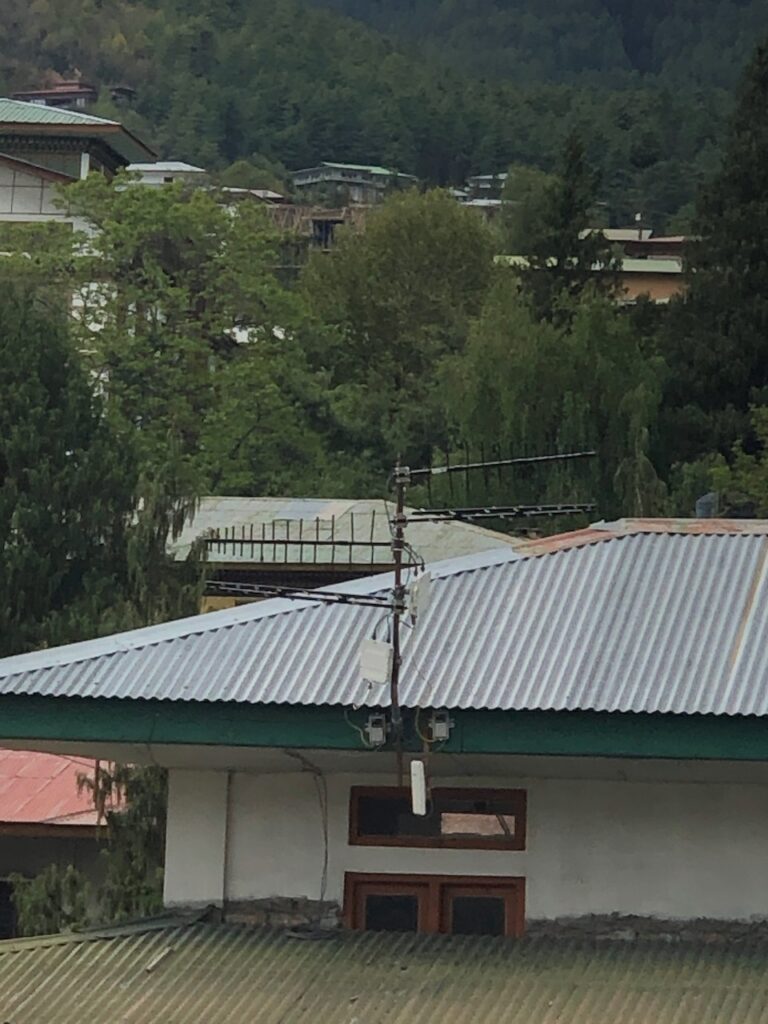
One of the Base Stations built on Rooftop

Far View of Base Station built on Rooftop
During the design and planning phase, Carlson Wireless (whose equipment had to be abandoned later) and Project Leader’s good friend, Mr. Jonathan Brewer, Telco Limited (telco2.co.nz) helped us validate the simulation of sites’ Radio Frequency (RF) coverage by TWVS signals. The Head Office of the Central Monastic body of Bhutan graciously and very happily supported us with recommendation and moral support to install in whichever monastery we chose. The monasteries themselves led by the Lamas (spiritual leader and head of the monastery) demonstrated highest keenness and enthusiasm to make connectivity and implementation successful so to have access to broadband Internet. They offered highest of the support and committed to providing us the logistics and meals – most of which had to be refused while we had to accept on rare occasions as to respect the customary tradition and not hurt them. We made our own arrangements with those and covered expenses to put absolutely no burden on them. All of them remarked they can only offer and will continue with the prayers and best wishes for the success of the trial and (business) venture of ours (NANO) and those of our funding partner, ISIF Asia grant, APNIC.
Our first contact with the direct beneficiary communities were through phone calls briefing them on the trial we are going to conduct at their community and how/what they will benefit – broadband Internet access with no cost to them. They invited us so much eagerly at the earliest when we asked permission for site survey visits to the communities. Their eagerness was understandable. They permitted us with open and complete access to any of their premises whenever we need to install equipment, pull power supply, lay cables and do the networking.
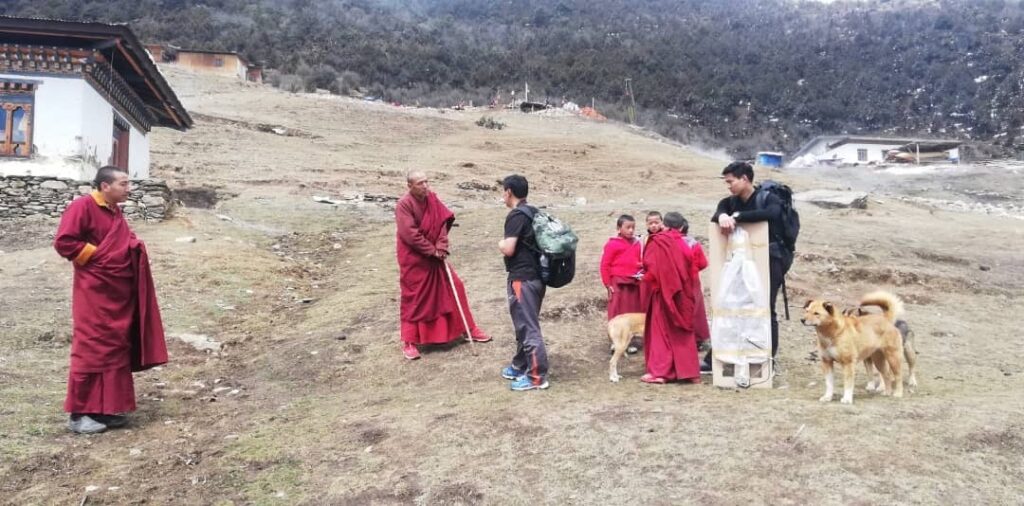
Project team briefing project to the Lama (Phajoding Monastery) right upon the visit for installation
Because sites are semi-rural and communities did not have knowledgeable person with IT, networking and Internet, we engaged from day one starting with the site survey and attached with us at least one person, a senior and the most enthusiastic teach in the case of monasteries and nunnery. The objective was to impart training to the persons so they can in turn help educate others on how to connect to Internet (through WiFi) and handle basic (level 1) operational support and troubleshooting. Most users of communities did not possess past experience of using Internet in WiFi environment while they carried smart phones. They had been using cellular mobile data. We engaged them in the installation of site’s poles and mounting of antennas, acquainting them through the orientation of antennas to achieve better signal gain/performace, and teaching them on the cable termination on (wireless) router, managing login access to router, taking the through simple configuration to creation of WiFi SSID and changing its password. The people attached with us fairly knew both spoken and written English. They could grasped well and as of today are able to perform level 1 operational support and troubleshooting, and are trained to provide us remote login access when there are advanced problems.
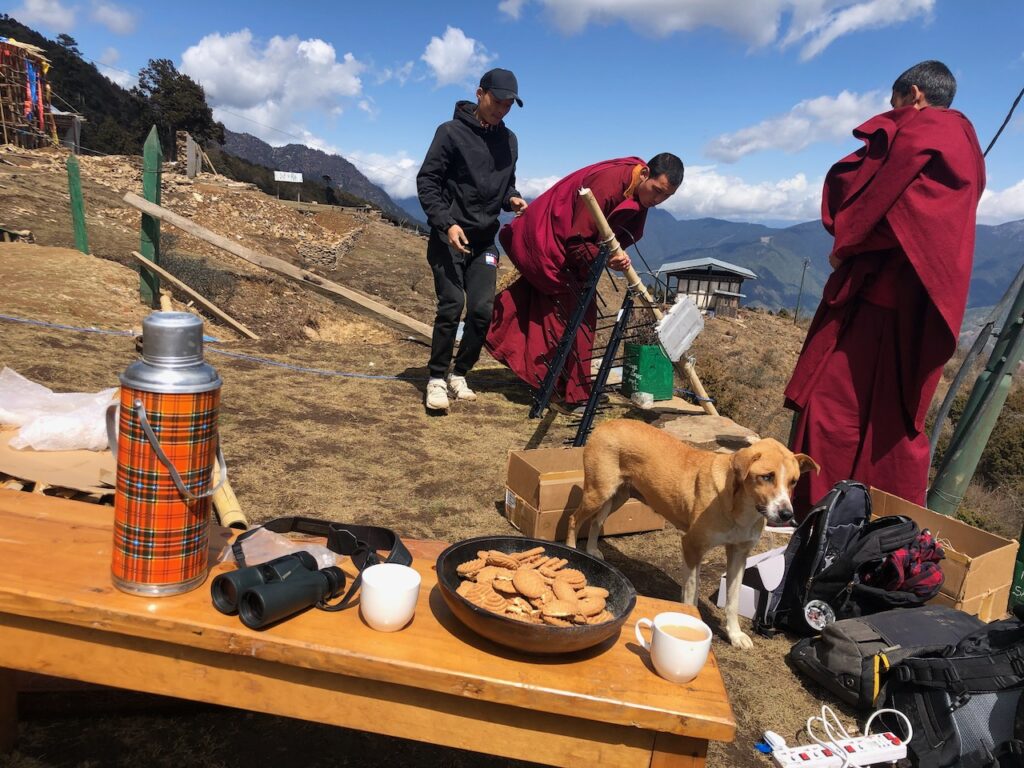
Monks (at Phajoding Monastery) rendering helping hands to project team

Client-side antenna at Talakha Monastery
The rest of the users in the communities helped us test Internet usability with layman’s methods by use of Internet like opening web browsers, social networking sites and using messaging apps like WeChat on their mobile devices and computers. Since the implementations were straight forward and simple at all sites, there was no need for the communities to put in lot of efforts and participation.
One of selected communities is Zilukha Monastery which is a nunnery consisting of 54 nuns. Their (female) population against the male counterpart in this project participation makes a ratio of 1:4, which is a fair ratio considering the dominance of men in Bhutan in majority of the areas and professions. We believe this is a sufficient gender inclusion as beneficiaries in the project. Equal inclusion or even near-about is highly unrealistic in Bhutan.
To add to diversity, we initially planned to include a school and police station guarding/serving the inmates – who are serving their final term and are let out in open space on good behavioral bond before their release. The sites of those two communities when tested were found not feasible while the RF simulations during the planning showed some strength in coverage – fair to reasonable signal strengths. And they had to be abandoned from implementation.
We do however have a residential home connection with 7 family members who all use Internet – husband and wife using Internet to run their small businesses when they are at home. Their children use Internet for educational and e-learning purpose. Broadband Internet has immensely helped the kids attend online teaching-learning these days during this COVID-19 situation.
With emerging TVWS technology completely new to us, a lot of efforts and time had to be invested to research and study about it including case studies of its global deployments, Neither were there many Original Equipment Manufacturers (OEMs) nor implementation cases on a big scale and numbers. We shortlisted and evaluated three TVWS manufacturers: Carlson Wireless Technologies, Runcom Communications and Saankhya Labs. When we were convinced with Carlson Wireless and were about to finalize Bill of Materials, we learnt they had very lengthy lead time, delay and some cases of even failing to manufacture/supply. Taking no risk, we switched to another OEM, Redline Communications (Canada) – who carried good recommendation on their company’s credibility and technology performance. That selection process and finally going with other OEM proved to be our big struggle that consumed our efforts and severely impacted our implementation timeline.
The other struggle was having to abandon two of the previously identified communities: Chamgang Lower Secondary School and Chamgang Police Station. The actual field tests prior to implementation found TVWS connectivity not feasible whereas RF simulation carried out during the planning stage showed some fair to reasonable coverage. Two new replacement communities had to be identified and connected – Talakha Monastery and Simtokha Monastery.
Project leader and three other engineers were involved almost fulltime during the implementation. Project team sought help from rest of the staff whenever necessary. NANO being a small organization, the project leader assisted by Accountant oversaw (i.e. multitasked) the complete procurement of all equipment and accessories.
The project afforded a rare opportunity and the first of its kind in Bhutan to develop capacity on an emerging TVWS technology that can be adopted to build last mile access network and also to create long backhaul in the remote areas with harsh terrains. We acquired vast knowledge, expertise and experience from site selection to implementation, optimization and operation of networks built on TVWS technology. That today, our project team can breathe easy to quickly deploy its networks. We shall continue to maintain and operate the current implementation as to gauge the long term sustainability – in terms of retaining our valuable learning and experience, and convert the current TVWS access network into a backhaul when more customers grow in those communities. We – the team and our organization can be the consultants and also implementers to other organizations in Bhutan (or anywhere) especially to the government who carry mandates to reach good Internet service to all the nook and corners of Bhutan, but are grappling with the constraints to connect the unserved.
We learnt many valuable lessons during the project implementation. If necessary, we can develop a case study of the TVWS technology implementation in Bhutan. That being the first case in Bhutan will be especially required and very helpful to convince on the appropriateness and suitability of the technology. We can document the whole project, come up with the guidelines for implementation and operation, and convert them into adopting as best practices in Bhutan.
The project by virtue of connecting a community of nunnery i.e. Zilukha Monastery comprising of 54 nuns (females) enabled broadband Internet access to them. During our community users review, we were convinced that both teachers and students put Internet to very good utility. They are now able to access online the study and other materials like prayers for which they lacked textbooks and found extremely challenging for someone to compile, type and prepare books. They could not only find materials, but can simply copy and paste without having to type whole books or prayers. They now feel they spend less time preparing materials and textbooks, and the time savings are instead utilized for more beneficial teaching and learning – these in turn helping develop their capacity. In the same way, Budhhist monks (males) in other monasteries benefited from broadband Internet to build their capacity. Before the project, these communities had no access to broadband Internet, as they were kind of marginalized whereas teachers and students going to the schools had Internet access.
As part of our administrative support, we dedicated 4 people to commit fully to the project implementation. That is why the actual implementation took short time. They were provided privileges to prioritize completion of the project and attend to other usual work/business only when time afforded them.
The project has triggered research interest on the emerging and new technologies within our organization. That is what we went through spending lot of time researching and studying on TVWS, their limited OEMs and their deployment cases worldwide to convince ourselves that it could be the technology to adopt. Technology itself is inspiring as we found it appropriate for very quick and efficient deployment in the mountainous terrain of Bhutan to take connectivity to the far end of the unserved where a sustainable business opportunity is expected with the expected upcoming growth of population and other settlements in the communities. The project team and the project organization are inspired by the TVWS technology and are seriously considering for implementation as we look to expand our Internet service coverage nationwide in Bhutan, to drive affordability and bridge the digital divide.
Project Evaluation
The project albeit delayed in implementation met all its objectives. We successfully conducted Bhutan’s First Trial with emerging TV White Space (TVWS) technology. It contributed in delivering broadband Internet access to the unserved areas. We concluded its technical (and even financial) appropriateness in Bhutan’s mountainous, thickly forested and rugged terrains where building wired network infrastructures is extremely challenging. Post implementation, the project brought many positive impacts to the communities who using online platforms and news, and are able to keep abreast of the latest global and local news aside their benefits in teaching-learning program and conduct of business for the residential home where children also used broadband Internet for e-learning. The project contributed significantly to the development of teaching-learning materials and as a result contributed to the development of monastic education. Those were so much needed during the current COVID-19 crisis.
An example of positive impact was narrated by the Ngawang Tenzin (Mr.) a researcher as Simtokha Monastery:
“My works have been made more fruitful. I can instantly get all materials online to carry out research. It has become lot easier for me to develop or compile textbooks and prayer books. I can keep up with updates on the Buddhist teachings delivered on WeChat while at the same time, I can send instruction materials in texts and voices messages to students and the interested. I am able to follow the latest news, and practise the do’s and don’ts of COVID-19 virus. All these have empowered me in the comfort of my office-cum-bedroom without having to spend anything personally as was necessary prior to the project.”

Researcher, Ngawang Phuntsho at work in Simtokha Monastery
Project delivered benefits to the nunnery, the female monastic community having 54 of them. This was as per the inclusion plan of both gender. Diversity inclusion got limited after having abandoned school and police (with inmates) communities. We do have a residential home connection which serves for business conduct, personal use and for children’s e-learning use of the broadband Internet.
The project has potential for growth as the current purchase has 4 base stations licensed to connect up to 80 client sites in total. Only client-side antenna, subscriber units (SUs) are required for purchase to add new sites. It has the capability with current licensing to further add many client sites and scale up the development and use of TVWS technology.
Project activities through the planning and implementation learning curve resulted in the development of knowledge, skills, expertise and earning of experience in the emerging TVWS technology that is likely to address in the fulfillment of connecting the unserved. Attached and engaged with the project team from the beginning of implementation to the end, and now supporting operation and use of Internet, both monks (male) and nuns (female) learnt and developed technical capability in the wireless connectivity, networks e.g. LAN and ICT infrastructures. This group and the users (males and females) are expected to developed high and good usability of Internet for their educational learning and growth.
The project afforded a rare opportunity and the first of its kind in Bhutan to develop capacity on the emerging TVWS technology that can be adopted to build last mile access network and also to create long backhaul in the remote areas with harsh terrains. We acquired vast knowledge, expertise and experience from site selection to implementation, optimization and operation of networks built on TVWS technology. That now, our project team can breathe easy to quickly deploy its network. We shall continue to maintain and operate the current implementation as to gauge its long term sustainability – in terms of retaining our valuable learning and experience, and convert the current TVWS access network into a backhaul when more customers grow in those communities. We – the team and our organization can be the consultants and also implementers to other organizations in Bhutan (or anywhere) especially to the government who carry mandates to reach good Internet service to all the nook and corners of Bhutan, but are grappling with the constraints to connect the unserved.
With our findings from the project implementation, we reached high confidence level to conclude that TVWS is an appropriate and efficient access technology to quickly provision connectivity and deliver broadband Internet to the unserved areas of Bhutan because of difficult terrains and remoteness. This technology that can also be used for building backhaul will always be considered in our plan to expand our network service our coverage to nationwide.
Lessons learnt include about having to choose the right OEMs with reliable equipment and experiences of deployments since the technology is in an emerging phase. The planning phase including the sites selection with detailed and proper RF coverage simulation and site survey are more important than implementation. Implementation activities are quick and easy if thorough planning was carried out in advance. Engaging the leaders and enthusiasts of the beneficiaries from commencement to the end and operation/support of project can save the time and troubles for the project team.
The project helped build and develop within our organization and the project team members a high level of capacity in the planning, implementation, optimization, operation and support of network connectivity built on the emerging TVWS technology. We can claim to be Bhutan’s first to successfully conduct trial in TVWS technology in connecting the unserved most efficiently.
Our experience clearly demonstrated the phase of project planning activities neccessitated by detailed site survey and visit are particularly more important. Getting the planning right makes implementation almost effortless and very quick in getting the communities connected on the fly.
| Indicators | Baseline | Project activities related to indicator | Outputs and outcomes | Status |
|---|---|---|---|---|
| How do you measure project progress, linked to the your objectives and the information reported on the Implementation and Dissemination sections of this report. | Refers to the initial situation when the projects haven’t started yet, and the results and effects are not visible over the beneficiary population. | Refer to how the project has been advancing in achieving the indicator at the moment the report is presented. Please include dates. | We understand change is part of implementing a project. It is very important to document the decision making process behind changes that affect project implementation in relation with the proposal that was originally approved. | Indicate the dates when the activity was started. Is the activity ongoing or has been completed? If it has been completed add the completion dates. |
| Technology appropriateness | Communities had no reliable fixed Internet connectivity access. All their requests to ISPs could not be materialized. | Implemented TVWS technology to build access network to the unserved communities | Unserved and deprived communities could avail broadband Internet built on access networks built TVWS technology. Actual deployment per site/community once the base station is took a working day or two. | Mid October 2018 - Mid March 2020 |
| Investment (financial) feasibility | Communities were asked to share major portion of the investments needed to build wireless or wired network infrastructure to connect them to broadband Internet | Per site/community can be driven low in terms in very quick implementation time, reliability and performance thus saving operational support and maintenance costs, and considering there are several users/subscribers in that community, cost can further be reduced due to the scale. | For this trial project, investment and broadband Internet access were provided at no cost to the communities. Investment on TVWS access network is competitive with other technologies. | For this trial project, investment and broadband Internet access were provided at no cost to the communities. Investment on TVWS access network is competitive with other technologies. |
Gender Equity and Inclusion
In the general context of Bhutan, our selection of Zilukha Monastery which is a nunnery consisting of 54 nuns is a good inclusion to provide fair opportunity to the gender i.e. women. All these nuns will benefit directly or indirectly from the project before which they were deprived of the Internet access. In this project, female vs male inclusion remains around a ratio of 1:4. This is a fair ratio considering the dominance of men in Bhutan in majority of the areas and professions. It is challenging and may not be possible to make inclusion even near to an equality while we wanted to accommodate more female participation; that’s because we did not come across to identify similar or potential beneficiaries and participation where project could (technically) feasibly reach the access network to them. Equal inclusion or even near-about is highly unrealistic in Bhutan.
Project Communication Strategy
With the beneficiary communities, we made direct contact by introducing ourselves and briefing about the project and its funding from ISIF Asia grant. At the same time, we briefed their parent organization. For example for the monasteries and nunnery which are under the Central Monastic Body, we briefed their Head Office formally and informally. Their Head Office was most welcoming and highly supportive for the obvious reason - offer of free broadband Internet connectivity to those unserved and deprived monasteries. They made strong encouragement and recommendation to all the identified monasteries and the nunnery. Within the community of beneficiaries, our briefing and visits during site surveys and implementation were good enough visibility/presence to educate, create awareness and disseminate information on the project and its intended outcomes. While the project tried reaching out to making gender inclusion as much fair as possible, we did not attempt to reach other specific groups as we believe access or not to Internet have similar bearing and impacts to one and all.
The current beneficiary communities were so quick to start sharing word of mouth (which is most effective in Bhutan owing to our close-knit society) to other communities in similar situation they were before the project. We received several inquiries and requests asking us to connect them too even if there were some costs they could bear/share. All had to be put on hold at this time.
With the licensing and regulatory body who approved and allocated TVWS spectrum to us, we shall share brief report to convey its technological appropriateness in Bhutan’s deployment. They do make a major funding decision and source fund ISPs/Telcos to reach Internet to the unreached under their Universal Service Fund (USF) programme. We plan to share similar report to the government recommending them for an inclusion of TVWS technology in their “Digital Drukyul (Bhutan)” flagship programme which attempts to connect the unserved areas as part of their objectives. This is an opportunity that ISPs like us will participate to build, operate and maintain the networks, and provide broadband Internet.
Recommendations and Use of Findings
Based on our implementation, we would like to recommend other organizations planning for broadband connectivity in the situations and contexts similar to Bhutan where terrains are mountainous, thickly forested and rugged to seriously consider TVWS technology to connect the remote and the unserved. The short term gain will be quick deployment to the very remote. Overall costs over mid to long term will be competitive with other wireless technologies and may become cheaper as TVWS technology matures. TVWS has better penetration capability of the obstructions and vegetations, and has far reach which are important parameters for consideration in Bhutan’s type of terrains.
Due to TVWS being relatively new and emerging technology with limited worldwide OEMs manufacturing the equipment, the main lesson learnt was in making the right selection of OEM and engaging them from the design phase itself. The right selection is to be based on their manufacturing lead time, equipment’s performance, market credibility and experience i.e. possession cases of implementation in geographical locations similar to where one plans to implement. The right selection of OEM will ease all other activities making actual on-field implementation very quick and operating to optimum performance with so much ease. While OEMs make varied claims of their capabilities, one should be cautious to not fall into their trap to come their experiential guinea pig.
Based on the brief report of our trial project that we might share to the regulator and the government, it is highly possible for them to consider TVWS technology in connecting the unserved areas of Bhutan. With that consideration, other ISPs/Telcos who are likely to be contracted the the project out to are expected to build and become future users of the technology. Telcos, now the mobile operators are likely to adopt TVWS technology to build backhaul for their cellular mobile networks in the remote areas.
Further, Bhutan has since last year embarked on the digitization of cable TV service. The government with their policy support and subsidy has mandated cable operators to migrate to the digital TV and expand the service to reach 90% of households from currently under 60%. Expansion in TV service coverage are required in the rural/remote areas for which TVWS could be deployed as a medium to transmit digital TV signals to carry certain number of channels.
TVWS remains a potential technology that could be deployed in Bhutan to connect broadband Internet and digital TV to the unserved rural and remote areas of Bhutan.
This work is licensed under a Creative Commons Attribution-ShareAlike 4.0 International License 
